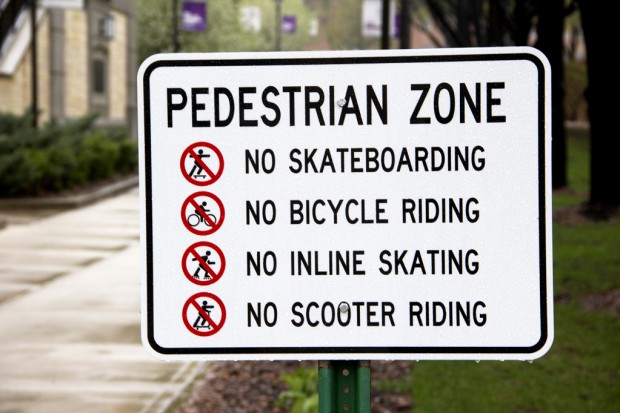
Two new regulatory signs have appeared on campus, one at each end of the main thoroughfare from the Lower Quad to the Upper Quad between the Anderson Athletic and Recreation Center and the Murray-Herrick Campus Center.
These signs have created “pedestrian zones” by prohibiting bicycling, skateboarding, inline skating and scooter-riding in designated areas on campus.
Public Safety’s Special Projects Manager William Carter lll said the signs were put up because of the concern that accidents may occur in the high-traffic areas.
“On the east side of the AARC, people going down the hill generally at a high rate of speed come to the bottom of the hill, and there’s a blind intersection there with vehicles or pedestrians that could be going east or west,” Carter said. “We’ve had some very close calls there as well as by the veranda.”
St. Thomas students have mixed reactions to the signs. Sophomore Zachary Galante thinks there may be a better safety alternative.
“I know it can be a little bit of a tricky intersection if people are flying down the hill too fast, but maybe we could put up a sign that says ‘slow’ instead of ‘no bikes allowed,’” Galante said.
Sophomore Michael Antolak doesn’t think the signs will do much to change students’ actions on campus.
“Frankly, I think it’s ridiculous,” Antolak said. “Based on that rule, students can’t go on bicycles or skates or scooters anywhere on campus without going around campus to get from North to South, and I just think that’s not going to change with a sign.”
Despite restrictions, the university still uses the paths to drive equipment cars, which freshman Sydney Benson said conflicts with the signs.
“I feel like (the signs) are really useless,” she said. “People aren’t going to pay attention, plus you still have those little cars that come through here, so it’s kind of weird.”
Although senior Max Wagner isn’t a fan of the rule, he doesn’t anticipate it affecting his means of transportation.
“I guess it really doesn’t affect me that much. I have Heelys, but it doesn’t say ‘no Heelys,’ so I’m good,” Wagner said.
Despite student reactions, Carter believes that it’s most important to make student safety a first priority.
“Be safe. Be conscious of your speed, be conscious of your movements, be conscious of the people around you,” he said. “And even though you’re on a vehicle and may be going fast … things can happen unexpectedly just like driving a car.”



